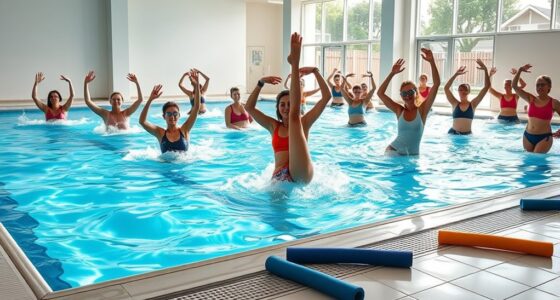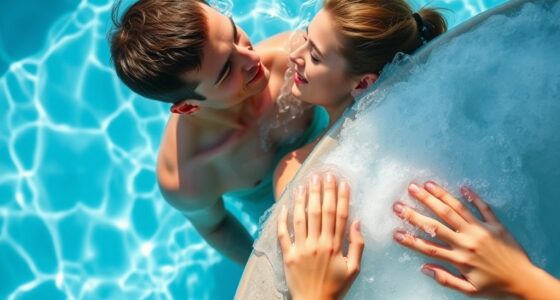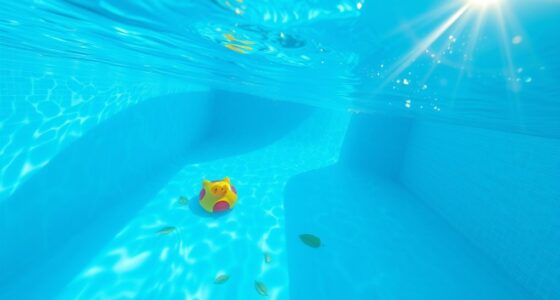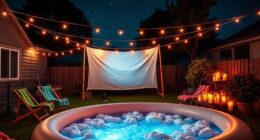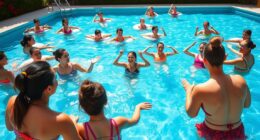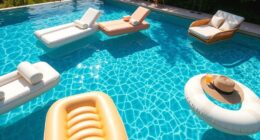To capture memorable pool moments underwater, focus on proper lighting by using waterproof strobes or underwater flashes and experiment with angles to reduce glare and shadows. Keep your equipment well-maintained, checking seals and cleaning ports to prevent leaks and smudges. Adjust camera settings, especially white balance and shutter speed, to match water conditions and movement. With the right techniques, you’ll create vibrant, sharp photos—continue exploring these tips to elevate your underwater shots even further.
Key Takeaways
- Use artificial lighting like waterproof strobes to enhance colors and reduce flatness in pool shots.
- Position lights carefully to minimize reflections and shadows, highlighting the subject’s details.
- Maintain your equipment regularly, checking seals and cleaning the lens to ensure clear, trouble-free images.
- Adjust camera settings such as white balance, shutter speed, and aperture to suit water conditions and motion.
- Experiment with different angles and light positions to capture dynamic, memorable pool moments.
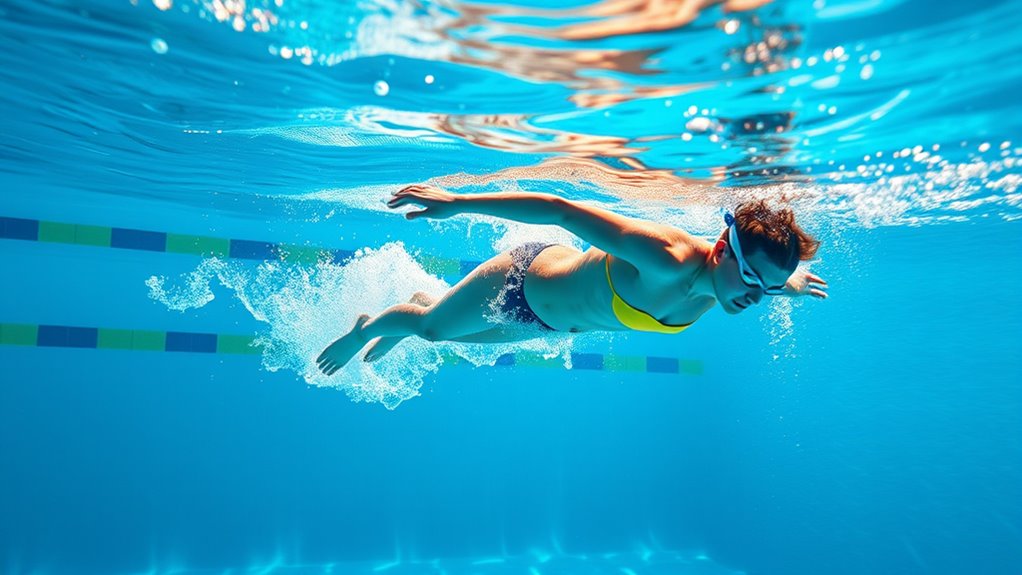
Ever wondered how to capture stunning images beneath the water’s surface? The key lies in understanding lighting techniques and making sure your equipment is well-maintained. When you’re diving into underwater photography in a pool, lighting plays a vital role. Natural sunlight can work in your favor if you shoot during the day when the water is clear and the light filters down evenly. However, relying solely on ambient light can lead to dull, flat images. To brighten your photos and bring out vibrant colors, you’ll want to incorporate artificial lighting. Waterproof strobes or underwater flash units are indispensable tools. Position them carefully to avoid harsh shadows or reflections, and experiment with angles to get the most flattering illumination. Using diffusers or softboxes can help spread the light evenly, reducing glare and highlighting your subject’s details. Additionally, understanding how light positioning affects your images can significantly improve your underwater photography results.
Equally important is equipment maintenance. Your camera and accessories need to be in top shape to produce sharp, clear images. Before every shoot, check your housing for any cracks or leaks, and ensure the O-rings are properly lubricated and sealed. This prevents water from damaging your gear. Clean your lens and port regularly, especially after each use, to remove smudges, salt, or debris that could impair image quality. Keep spare batteries and memory cards handy so you don’t miss a perfect shot due to technical issues. Proper maintenance means you’ll spend less time troubleshooting and more time capturing those memorable pool moments.
As you shoot underwater, be mindful of your camera settings. Adjust the white balance to compensate for the blue-tinted water, or set it to auto if you’re unsure. Use a narrow aperture to keep your subject in focus while blurring the background, and set a fast shutter speed to freeze motion, especially if your subject is swimming or splashing. Practice makes perfect, so take plenty of test shots and review them to refine your technique.
Frequently Asked Questions
What Camera Settings Are Best for Underwater Pool Shots?
To get great underwater pool shots, set your underwater camera type to manual mode, adjusting ISO around 100-200 for clarity. Use a wide-angle lens and a fast shutter speed of 1/250 sec to freeze motion. Adjust the aperture to f/8 for depth of field. Incorporate pool accessories like waterproof housings and lighting to enhance your shots. Keep your settings steady, and experiment to find what works best for your pool environment.
How Do I Prevent Water Spots on My Lens?
To prevent water spots on your lens, make sure to regularly clean your lens with a lens cleaning solution and microfiber cloth after each shot. Use protective filters to shield your lens from water splashes and mineral deposits. Before diving, check for any smudges or spots, and consider applying a water-repellent coating. These steps help keep your images clear and your lens in top condition for those perfect pool shots.
What Lighting Techniques Enhance Pool Photos?
Did you know that natural reflected light can brighten pool photos by up to 30%? To enhance your shots, shoot during midday when sunlight hits the water directly. Use a polarizing filter to reduce glare and boost color enhancement. Position yourself to capture reflected light bouncing off the pool’s surface, creating vibrant, dynamic images. Proper lighting techniques make your pool photos pop with rich colors and mesmerizing reflections.
How Can I Stabilize My Camera Underwater?
To stabilize your camera underwater, use an underwater camera housing with good grip and control. Practice buoyancy control by adjusting your breathing and body position to stay steady. Keep your elbows close to your body to reduce movement, and move slowly to minimize shake. Using a tripod or stabilizer designed for underwater use can also help, but mastering buoyancy and holding your camera securely are key for clear, sharp shots.
What Are Common Mistakes to Avoid in Pool Photography?
Avoid common mistakes like neglecting pool safety and skipping equipment maintenance. You might focus too much on the shot and forget about safety rules, risking accidents. Also, failing to clean or check your gear can cause blurry images or damage. Keep your camera dry and safe, stay aware of your surroundings, and regularly maintain your equipment. Balancing these aspects helps you capture clear, vibrant photos while ensuring safety and gear longevity.
Conclusion
By applying these underwater photography tips, you’ll capture stunning pool moments that last a lifetime. Imagine snapping a friend’s joyful splash or a shimmering reflection—these images become treasured memories. For instance, a hobbyist improved their shots by adjusting lighting and angles, resulting in breathtaking photos that impressed everyone. Remember, practice and experimentation reveal your best shots. Immerse yourself with confidence, and let your creativity turn simple pool days into extraordinary visual stories.

